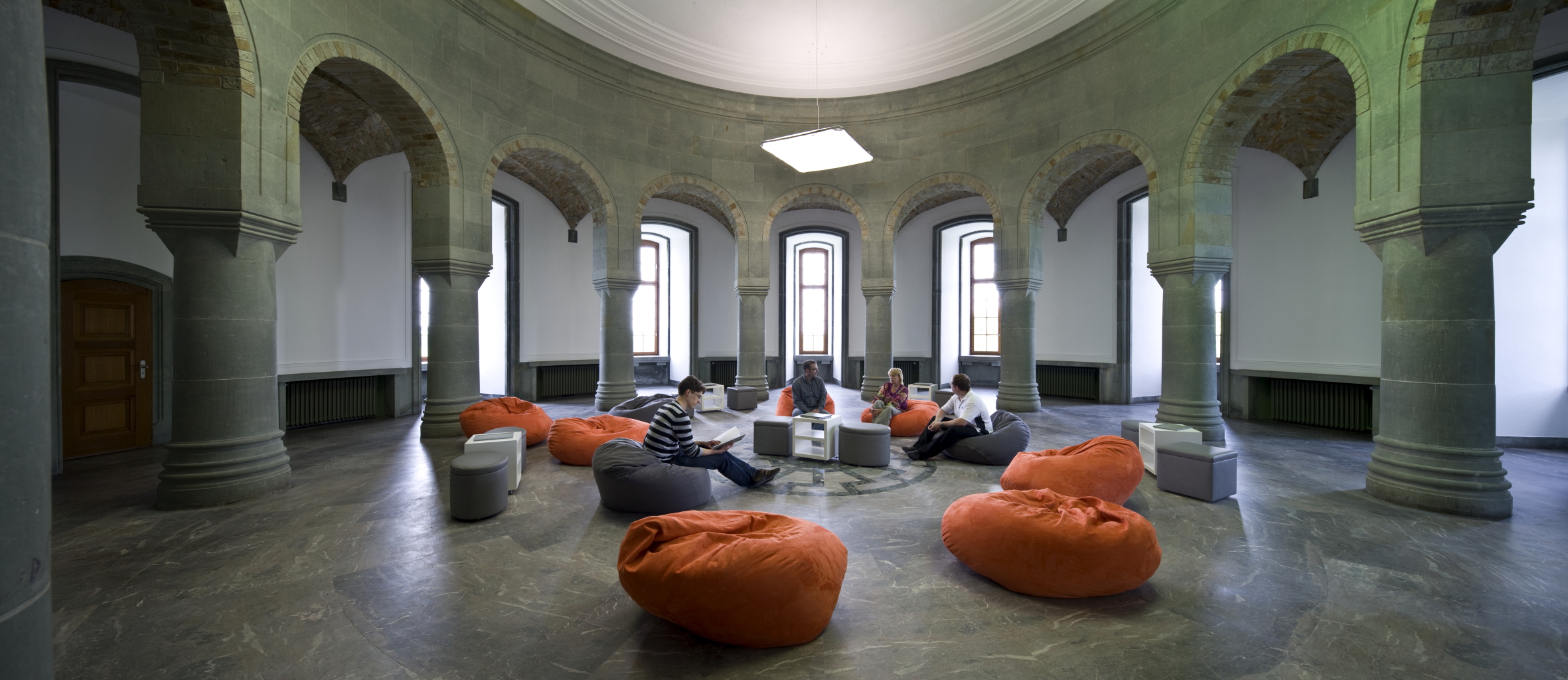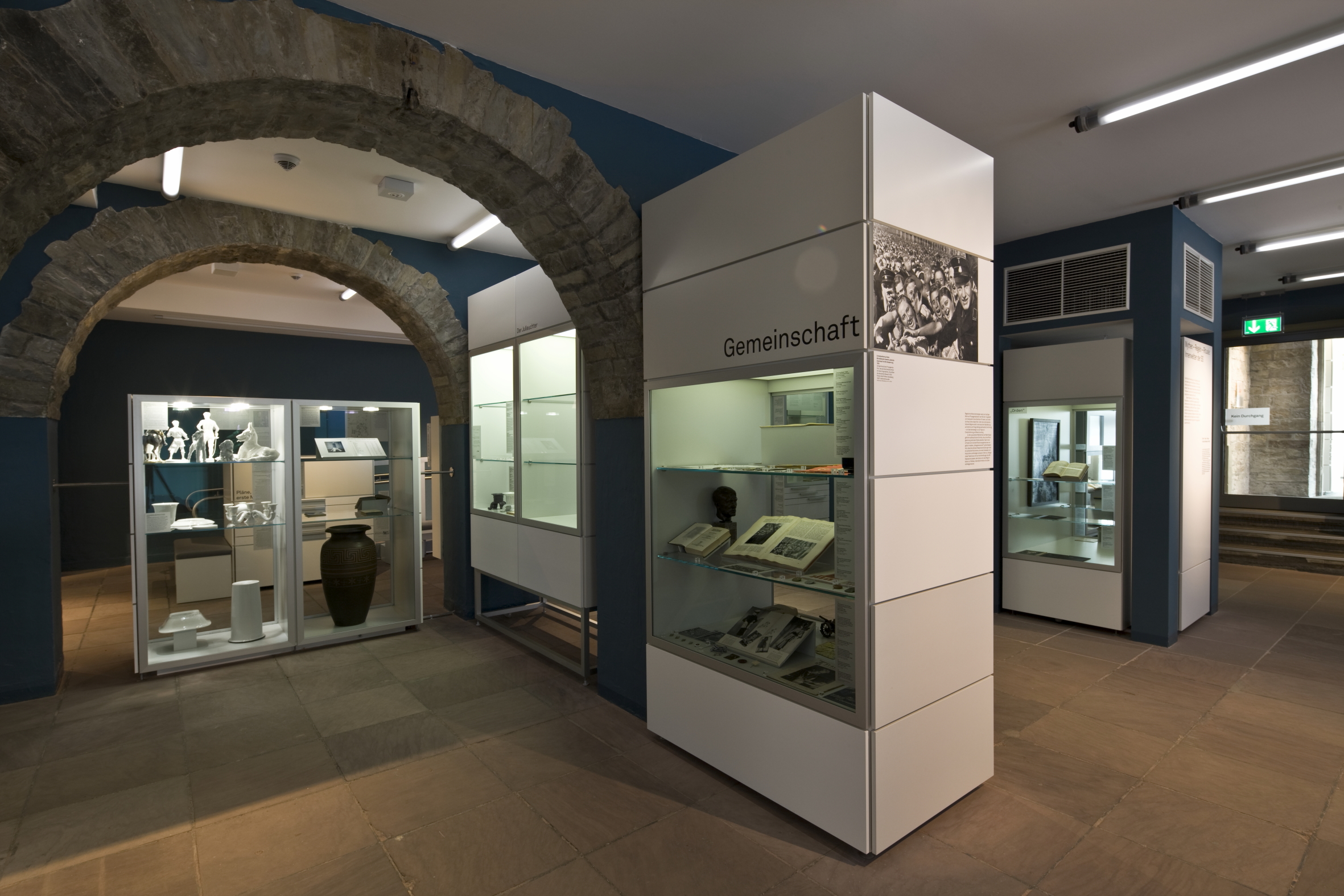Cover picture: The crypt diplays reconstructions of the memorial cycle by Josef Glahé , first shown in in 1950, and incorporates Expressionist motifs depicting the horrors of war | M. Groppe, 2010, Kreismuseum Wewelsburg
By Kirsten John-Stucke, Director of the Kreismuseum Wewelsburg
The Wewelsburg is a Renaissance castle that was built at the beginning of the 17th century on behalf of the Prince Bishops of Paderborn, located 20 km south-west of Paderborn (North Rhine-Westphalia). The castle, in the trusteeship of the district of Paderborn, houses a district museum with two historical departments: the “Historical Museum of the Prince-Bishopric of Paderborn” which presents the history of the region from the beginnings of human settlement to the end of the Prince-Bishopric of Paderborn at the beginning of the 19th century and the “Wewelsburg Remembrance and Memorial Museum 1933-1945,” with its permanent exhibition “Ideology and Terror of the SS“. This exhibition was redesigned in 2010 and provides extensive information on both the local activities of the Schutzstaffel (SS) in Wewelsburg and the general history of the Schutzstaffel within the NSDAP. Simultaneously, the victims of SS violence in Wewelsburg are commemorated at the location. Reichsführer-SS Heinrich Himmler leased Wewelsburg in 1934 and planned to extend the castle by adding a huge complex of buildings to transform it into a centre of ideology and a location for the SS order’s sense of elitist self-affirmation. For the construction work he used prisoners from the concentration camp set up in the village especially for this purpose. Of the approximately 3,900 inmates, at least 1,285 died as a result of inhumane living conditions and abuse by the SS.

Due to its history, Wewelsburg Castle is regarded as being particularly suited for presenting not only the crimes of the SS, but also the varied facets of the ideology and worldview as well as the historical narrative of the criminal organisation of National Socialism. The historic location of Wewelsburg is of particular importance in this regard – historical culture and its mediation cannot be imagined without fixed spatial points. At a time when virtual networks seem to bring places and events in the world closer together, people search intuitively for such fixed points and a genuine visit to an “authentic” historical site is perceived as being unique. The past becomes both tangible and perceivable at these “original” locations. The historical site of Wewelsburg, circumscribed by the totalitarianism and territory of the SS, is therefore more strongly integrated than before into both the exhibition design and its didactic communication.
The new exhibition was intentionally installed in the underground levels of the listed, former SS guard building on the forecourt of Wewelsburg Castle as this is where the architectural traces of the SS project are particularly prominent. Architecturally-related panels explain the history of this location in the exhibition. Along the castle, outdoor columns in the castle’s moat reference the structural modifications carried out by the SS. Visitors reach the North Tower along this route with its “SS Obergruppenführer Hall” and the “Crypt”. These are two rooms that were architecturally remodelled by the SS but never put to use. They remained unharmed at the end of the war although the SS carried out extensive detonations. Since the 1990s they have increasingly become a magnet for right-wing extremists and right-wing esoterics who wish to visit Wewelsburg due to its importance as a central meeting place of the SS. Numerous legends and myths are linked to the castle complex as a “sacred” fortress or supposedly secret place of worship.
The North Tower therefore needed a special design to prevent any possible element of fascination in connection with this dominant architecture. In the “Crypt”, which had been converted by the SS into an enormous Greek domed hall, reconstructions of the memorial cycle of the artist Josef Glahé are displayed, first shown in the crypt in 1950 and incorporating Expressionist motifs depicting the horrors of war. In this way the formerly solemn and highly mythical atmosphere is modified. The SS Obergruppenführer Hall is equipped with colourful bean bags to break up the focus of the architecture from the sunwheel mosaic centrally embedded in the floor. The visitors, sinking into the beanbags, adopt an unfamiliar posture and experience new perspectives. Since the 1990s this specific sunwheel motif has been referred to as the “Black Sun” and functions in right-wing esoteric milieus and extremely right-wing political circles as a symbol of salvation and recognition, even as a substitute for the forbidden swastika. Here, too, the presumed aura of a supposed cult space had to be eliminated.
The exhibition concept is based on the theory that the historical awareness of today’s generations of visitors to museums is influenced by the social upheavals and processes of our contemporary globalised world. In more and more areas of life, modern individuals must decide for themselves how they wish to shape their existences and how they desire to confront society and history. The exhibition therefore strives for an open presentation of historical developments and universal values, such as self-determination and human rights, and encourages visitors towards self-reflection. The focus is no longer on a historical narrative but on the micro level, on the diversity of experiences and personal perspectives. This approach attempts to emphasise the fragmentary nature of historical tradition. One principle of the exhibition is multiperspectivity, and this can be particularly experienced in the exhibition’s biographical material. Whilst the biographies of members of the SS are presented at the beginning of the exhibition tour, former concentration camp inmates subsequently become the focus of the exhibition.
At the same time, the subjective perceptions of the village population of Wewelsburg are documented; it becomes clear that the story is composed of narratives remembered and experienced in different ways. The display exponents and drawer cabinets themselves are also multifunctional: they function as carriers of the exhibition texts and the photo and document reproductions as well as places of storage for the original objects and documents. The exhibits in the first exhibition space are arranged in strict formation but are presented in the following rooms according to a modular principle and their specific themes. The network of information does not provide a complete picture of history but encourages visitors to interpret the story themselves.

A special feature of this exhibition is the museum concept of largely dispensing with reconstructions and presenting original objects. In addition to objects from the living environment of concentration camp victims, real objects from the SS milieu are being increasingly shown for the first time. Most of these exhibits are ideologically charged and so-called “affirmative” objects with which the SS symbolised its internal communitisation and elitist position. In order to avoid a fascination with and exaggeration of the objects, a responsible sense of contextualisation is required. This can be seen for example with the display of the ‘Julleuchter’. Himmler presented this ceramic candlestick with runic symbols to married SS men. Candles were lit on the Yule, the surrogate celebration for the Christian Christmas. The candlestick is thus an example of the creation of a substitute religion. In the exhibition, the intended use of the candlesticks is put in relation to their production. They were made by prisoners from the Dachau and Neuengamme concentration camps. The seemingly harmless appearance of the object is thus placed in the context of SS crimes, here the exploitation of concentration camp prisoners. Sober and neutral presentation strategies such as the arrangement of the repository and mass presentation are intended to remove any presumed sense of magic and mystery from the objects. The showcases can be viewed from several sides and provide various views of the objects; there is as such no fixed, predetermined view of the exhibits, just as there is no predetermined view of the history of the SS. In contrast to the sober presentation of “affirmative” objects from the world of the SS, genuine objects from the realm of concentration camps are intentionally exhibited in such a way that the “aesthetic language” of these original objects should bear impact on the visitors. The showcases surround the objects as protective enclosures and accent lighting highlights their special features. Quotations and reminiscences of contemporary witnesses and villagers can be called up at media terminals. Survivors of the Niederhagen concentration camp relate their personal interpretations and memories in intensive, biographical interviews. The interview excerpts are not intended to clarify historical facts but rather to support the better understanding of events from the perspective of the concentration camp victims. This empathetic, personal aspect of the exhibition is deliberately not granted to members of the SS, and their reminiscences cannot be called up via the terminals.

The “Wewelsburg Commemorative and Memorial Centre 1933 – 1945” sees itself, since its foundation in 1982, as an extracurricular place of learning offering extensive didactic, historical-political seminar programmes for groups of young people and adults. Special projects also address issues such as discrimination and moral courage. The uncovering of the SS shooting range, filled up after the war, is regularly driven forward as part of work camps. Special exhibitions, readings and lectures about National-Socialist history and for the prevention of right-wing extremism and racism form part of the permanent programme. More than 50,000 people visit the memorial every year, whilst the proportion of visitors recognisable as right-wing extremists is marginal. The concern that the number of neo-Nazis might increase due to the presentation of “affirmative” objects in the exhibition from the SS environment has remained unfounded. On the internet it is more a case of finding angry statements about what they consider to be the “disrespectful treatment” of the North Tower, their “place of consecration”. In addition to historical-political educational work and information about Nazi perpetrators, the commemoration of concentration camp victims is of high importance. Contacts are maintained to concentration camp survivors and their relatives but also to relatives of SS members who wish to learn more about their fathers and grandfathers. In this regard the memorial fulfils its task as a research centre for the history of the SS and the Niederhagen concentration camp. Visitors have access to an archival collection, a media library with an extensive collection of contemporary witness interviews with survivors and village residents, and a specialist library.
